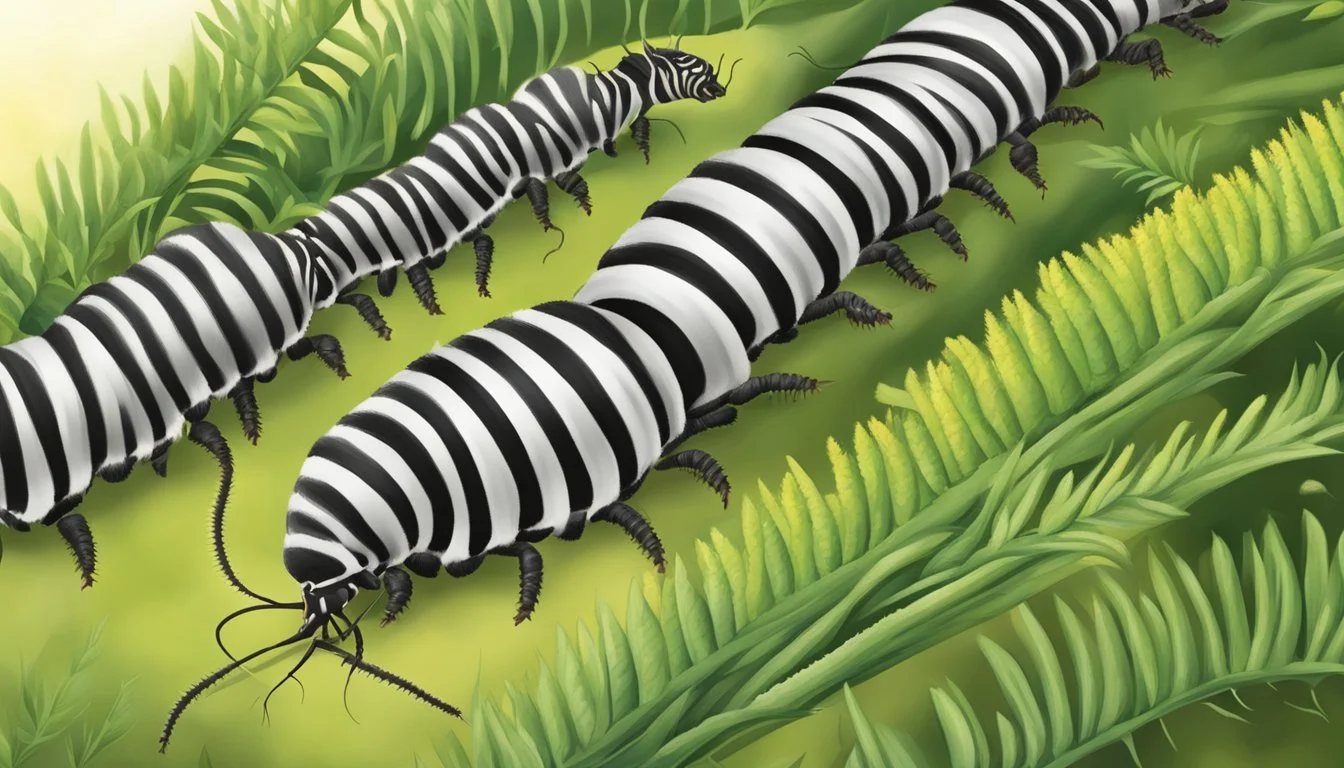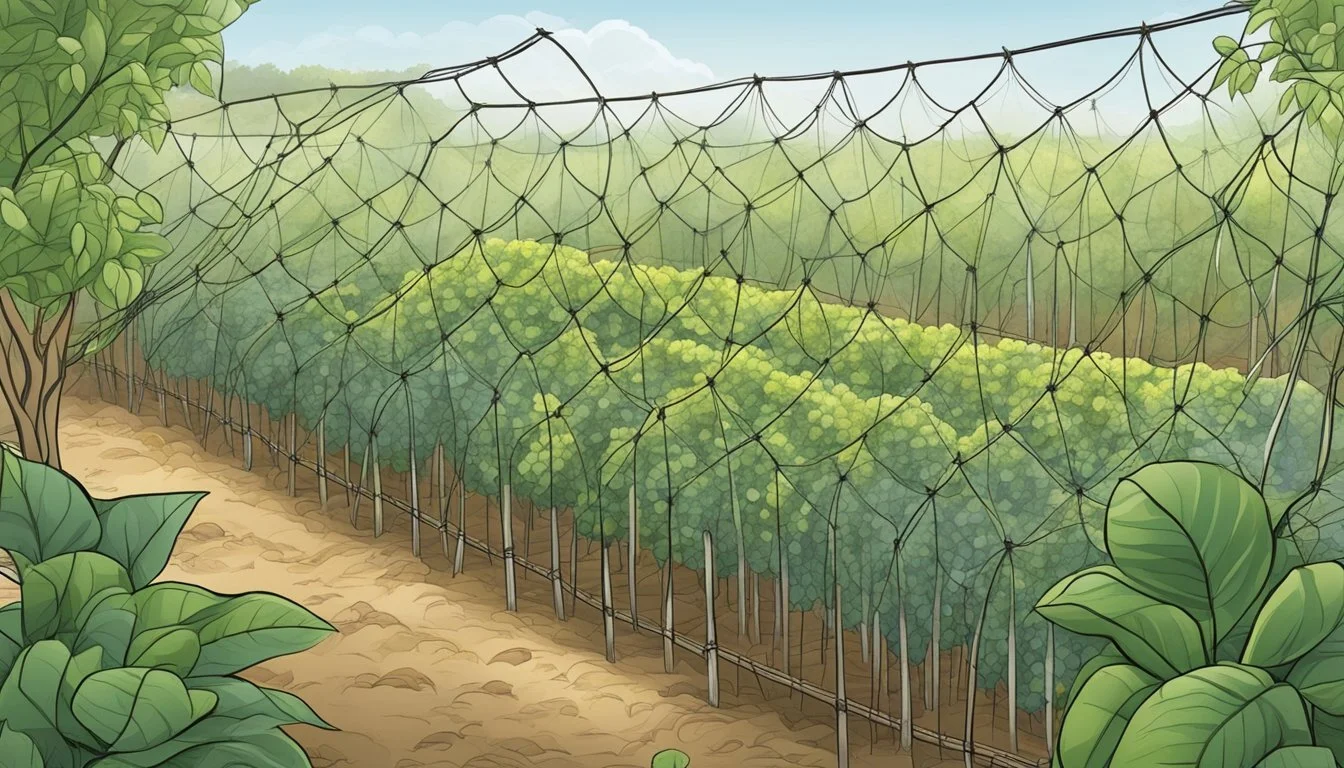Protecting Crops from Zebra Caterpillar
Essential Management Strategies
The zebra caterpillar, the larval stage of a noctuid moth, poses a significant threat to a variety of cultivated plants, including cabbages and beets. Characterized by its distinctive black and yellow longitudinal stripes, this pest is not only striking in appearance but also in its capacity for damage. Farmers and gardeners must remain vigilant, as the larvae can severely impact the health and yield of their crops.
Effective management strategies are essential in safeguarding crops from these voracious eaters. Understanding their life cycle, including the moth and larvae stages, is crucial for timely interventions. Although not typically known as serious pests, zebra caterpillars can cause considerable damage in large numbers, particularly during their peak feeding times in late spring and again in late summer.
Agricultural professionals and enthusiasts must employ a blend of monitoring, preventive measures, and targeted treatments to protect their plants. Knowledge of the zebra caterpillar's feeding habits, preferred plants, and natural predators enables the development of integrated pest management plans that minimize the need for chemical control, thus promoting sustainable agriculture practices.
Biology and Identification
Understanding the biology and characteristics of the zebra caterpillar is crucial for effective identification and management in crop protection strategies.
Lifecycle of the Zebra Caterpillar
The zebra caterpillar (Melanchra picta) undergoes a complete metamorphosis during its life cycle. This process includes four distinct stages: eggs, larvae (caterpillar), pupae, and adult moth. Eggs are laid by the adult female moths on the underside of leaves. After hatching, the larvae feed voraciously on a wide variety of host plants, maturing through several instars before transitioning into pupae. Ultimately, they emerge as adult moths, ready to perpetuate the cycle.
Physical Characteristics
The larvae of the zebra caterpillar can be recognized by their striking black and white markings with yellow striping. They are generally black with white markings and have a yellow striping. They grow to approximately 35 to 40 millimeters in length when mature. The adult moth exhibits a chestnut- or reddish-brown coloration with purplish-brown mottling on the wings. The forewings of the adult moth are typically colored to blend into their environment, whereas the whitish hind wings have pale brown margins. The species has a notable wingspan, which is characteristic of the adults within this genus.
Crops Affected and Signs of Infestation
Zebra caterpillars pose a significant threat to various vegetable crops by causing extensive feeding damage. Vigilant observation of host plants is essential for early detection and control of infestations.
Common Host Crops
Zebra caterpillars exhibit a broad host range, infesting several vegetable gardens and crops. They are particularly fond of tomato and aster plants, and these are often the most visibly affected. However, their appetite is not limited to these, as they can also be found on numerous other flowers and foliage within a garden.
Detecting Feeding Damage
The first sign of zebra caterpillar infestation is often the damage they inflict on foliage and flowers. Look for irregular holes and chewed edges on leaves, which indicate active feeding. Tomato plants can exhibit defoliation, with younger leaves and tender shoots being the prime targets. Detecting these early signs of damage in vegetable gardens is crucial for timely intervention.
Preventive Measures
Preventive measures are essential in protecting crops from the zebra caterpillar, an insect known for its distinctive black and yellow stripes. Effective management strategies involve cultural and biological tactics that reduce the caterpillar's impact on crops without excessive reliance on chemicals.
Cultural Controls
To keep zebra caterpillars at bay, farmers and gardeners should focus on cultural practices that create unfavorable conditions for these pests. It is important to rotate crops and manage soil health to prevent the buildup of caterpillar populations. Planting times can be adjusted to avoid peak caterpillar seasons, thereby reducing the likelihood of infestation. Regular weed removal ensures that the caterpillar's potential habitats are minimized, and landscape maintenance can further deter their presence in the garden.
Crop Rotation: Alternating crops yearly to prevent pest establishment.
Soil Management: Maintaining soil health to support robust plant growth.
Timely Planting: Scheduling planting to avoid peak caterpillar activity.
Weed Control: Keeping the garden free of weeds that can harbor caterpillars.
Biological Controls
Biological controls involve the introduction or conservation of natural predators that feed on zebra caterpillars. Such predators are allies in keeping caterpillar numbers in check. Among the most effective are certain species of wasps and birds that prey on these caterpillars. The use of pesticides derived from naturally occurring bacteria, such as Bacillus thuringiensis (B.t.), specifically targets caterpillars while being safe for other insects.
Natural Predators: Encouraging wasps, birds, and other beneficial species.
Bacillus thuringiensis (B.t.): Applying this bacterium to selectively target caterpillar larvae.
By employing these preventative strategies, it is possible to protect crops from the harmful effects of zebra caterpillars and ensure sustainable agriculture practices.
Control and Management Strategies
Effective management of zebra caterpillars involves a combination of methods including organic pesticides, synthetic pesticides, and mechanical as well as physical controls. These strategies aim to minimize crop damage while adhering to sustainable farming practices.
Organic Pesticides
Organic pesticides offer a way to control zebra caterpillars without adding synthetic chemicals to the environment. Bacillus thuringiensis (Bt), found in products like Dipel, is a naturally occurring soil bacterium that is toxic to many insect pests including zebra caterpillars when ingested. Neem oil and spinosad are other organic options. Neem oil acts as a deterrent affecting the life cycle of caterpillars, while spinosad, derived from a naturally occurring soil-dwelling bacterium, selectively targets caterpillars and beneficial insects less so. Pyrethrin, derived from chrysanthemum flowers, is a fast-acting insecticide, yet it decomposes quickly, minimizing its environmental impact.
Bacillus thuringiensis products such as Dipel
Neem oil for deterring larvae
Spinosad for selective targeting
Pyrethrin for immediate action
Synthetic Pesticides
Synthetic pesticides, such as Sevin (carbaryl) or Malathion, are designed to provide more aggressive control of zebra caterpillar infestations. These are broad-spectrum insecticides and may be effective against a range of pests. Application must be done carefully and in accordance with the pesticide label to avoid harm to beneficial insects and to comply with safety regulations. Farmers should consult their cooperative extension office for guidance on the most appropriate synthetic pesticide options for their specific situation.
Sevin for broad-spectrum control
Malathion for effective elimination
Always follow the pesticide label
Consult cooperative extension office for tailored advice
Mechanical and Physical Controls
Mechanical and physical control options include measures like hand-picking caterpillars off plants. This method can be effective in home gardens or on a small scale but may not be viable for larger infestations. Destroying larvae found on crops can prevent them from maturing and multiplying. The use of pheromone traps is another physical control measure that can help to monitor and reduce the population of adult moths, thereby preventing laying of eggs that hatch into caterpillars.
Hand-pick caterpillars in smaller settings
Destroy larvae to prevent future infestations
Pheromone traps for adult moth population control
Monitoring and Thresholds
Effective management of the zebra caterpillar involves regular monitoring and understanding the critical thresholds at which to take action. This ensures timely intervention to prevent significant crop damage.
Scouting and Sampling
Farmers and gardeners should routinely scout their fields, gardens, and landscape areas for signs of the zebra caterpillar, paying close attention to feeding damage on a wide variety of plant species. Regular sampling involves checking for the presence of eggs, larvae, and signs of feeding on leaves. Trees are less commonly affected but should not be neglected. Early detection is key to minimize the impact of these pests.
How to Scout:
Examine leaves for eggs and larvae
Look for distinctive black and white markings and yellow stripes of the caterpillar
Note the amount and location of feeding damage
Threshold Levels for Intervention
Identifying the correct moment for intervention is crucial. Effective action thresholds for the zebra caterpillar have been established, such as testing action thresholds based on TPP nymphs per 100 middle leaves that correlate with commercial damage levels. These thresholds inform farmers when the level of pests or damage warrants control measures to avoid economic loss.
Intervention Thresholds:
Economic thresholds: Vary by crop and cost of treatment.
Recommended action: When zebra caterpillar populations exceed levels that history has shown will lead to economically significant damage.
Environmental Considerations
In the context of protecting crops from the zebra caterpillar, it is imperative to acknowledge the role of environmental considerations. These factors influence the balance between effectively managing pest populations and preserving the health of the ecosystem, especially concerning beneficial insects.
Impact on Beneficial Insects
When employing methods to control zebra caterpillar populations, one must consider the potential impacts on beneficial insects, such as pollinators and natural predators. These insects play a crucial role in the environment by aiding in pollination and controlling pests naturally, contributing to a healthy agricultural system.
Pollinators: These insects, including bees and butterflies, are essential for the pollination of many crops. It is crucial to select control methods that do not harm these insects or disrupt their activity.
Natural Enemies and Predators: Lacewings, lady beetles, and parasitoid wasps are natural adversaries of the zebra caterpillar. Methods that preserve these natural predators are preferred as they help maintain pest populations at manageable levels without the need for chemical interventions.
Organic Products: When considering treatments, organic products that are less harmful to beneficial insects might be chosen. Such products often break down more quickly in the environment, reducing the risk of long-term negative effects on non-target species.
The conservation of these beneficial insects must be a priority. It is vital to select pest management strategies that support the overall health of the ecosystem while effectively addressing the threat of the zebra caterpillar on crops.
Case Studies and Expert Opinions
In addressing the management of zebra caterpillars, insights from academic research and applied agricultural practices provide practical approaches for protecting crops. These studies and recommendations, particularly focused on yield preservation and effective pest control in fields, offer a robust framework for combatting this pest in vegetable crops.
Research by Colorado State University
Colorado State University has conducted extensive research on zebra caterpillars, offering valuable information on their life cycle, habits, and the extent of damage they can inflict on crops. Findings show that zebra caterpillar damage is generally minimal and often insignificant in terms of affecting the overall yield. The research suggests that while caterpillars may be present on plants, the resulting damage is likely to be dispersed across the planting, limiting its impact. For the full study and detailed findings, interested readers can access the university's publication here.
Recommendations from Agricultural Extensions
Agricultural Extension offices, such as the cooperative extension service, play a pivotal role in disseminating knowledge from research institutions to farmers. Their hands-on expertise translates into actionable strategies to manage pests like the zebra caterpillar. They often advise on monitoring for pests during the key growth periods of crops and implementing integrated pest management techniques. Agricultural Extensions emphasize the importance of identifying the caterpillar species accurately, as this informs the choice of control measures and their timing. Diverse tactics ranging from natural predators to targeted insecticide applications are evaluated for their effectiveness in protecting vegetable crops in the field. For a comprehensive guide on identifying and managing caterpillar pests of the cabbage family, which includes the zebra caterpillar, refer to the guidance provided by an extension office here.
Effective Timing and Application
Proper timing and application methods are crucial when protecting crops from the zebra caterpillar to ensure maximum effectiveness while minimizing impact on the environment. This involves understanding the pest's life cycle and the optimal conditions for pesticide application.
Seasonal Timing
Zebra caterpillars generally have their peak feeding time during the growing season of the host plants. Monitoring should commence early in the season to detect the presence of larvae, as control measures are more effective when the caterpillars are young and small. It's essential to follow a time-sensitive plan, targeting applications before the caterpillars reach maturity at around 35 to 40 millimeters long, as highlighted by the Top Crop Manager article.
Weather and Application
Weather conditions significantly affect the application of pesticides. Optimal applications are made during calm weather, ideally when there's little to no wind, to prevent drift and ensure the pesticide remains on the target area. Additionally, treatments should be avoided during periods of heavy rain to prevent pesticide wash-off, ensuring efficacy and reducing the need for repeated applications. It's important to also consider the time of day, leveraging periods when caterpillars are most active and when beneficial insects are least active.
Beyond the Field
The zebra caterpillar, with its distinctive stripes, is a pest that can affect a range of perennials and shrubs in both landscapes and home gardens.
Landscape and Home Gardening Considerations
When zebra caterpillars invade a home garden, they tend to target a variety of plants. Home gardeners can identify these caterpillars by their conspicuous black and yellow longitudinal stripes. They need to be vigilant, as these caterpillars can cause significant damage to ornamental plants as well as vegetables.
For landscape care, it's imperative to monitor for these pests regularly. Zebra caterpillars can feed on a wide range of host plants. They are known to favor perennials and can often be spotted on shrubs. Early detection is crucial to prevent an infestation from escalating.
Preventative measures can also be taken to safeguard plants in the garden:
Regular Inspection: Check plants frequently for the presence of zebra caterpillars, especially on the undersides of leaves.
Physical Removal: If caterpillars are found in small numbers, they can be removed by hand.
Natural Predators: Encouraging birds in the garden by using bird feeders may increase predation on caterpillars.
Barrier Methods: Using floating row covers can prevent moths from laying eggs on plants.
Gardening practices such as rotating crops and avoiding monocultures can make the environment less appealing for zebra caterpillars to lay eggs. Similarly, maintaining diversity in the garden with a mix of annuals and perennials can help minimize the caterpillars' impact.
Frequently Asked Questions
This section answers common queries related to effectively protecting crops against zebra caterpillars, offering insight on natural prevention, vulnerable plants, non-toxic control methods, beneficial insects, eco-friendly chemical treatments, and the caterpillar's lifecycle stages.
How can I naturally prevent zebra caterpillars from damaging my crops?
One can prevent zebra caterpillars by applying neem oil, a natural pesticide, to the leaves and stems of plants. Consistent application as directed ensures effective protection without harming the environment.
What plants are commonly affected by zebra caterpillars?
Zebra caterpillars predominantly target canola plants, distinguishing themselves with their striped appearance. These caterpillars also infest various crops such as broccoli and cauliflower.
What are the non-toxic methods to control zebra caterpillar infestations?
Apart from neem oil, insecticidal soaps serve as a safe and effective solution for controlling zebra caterpillars on crops. These soaps target the larvae without residual toxicity to the environment.
Are there any beneficial insects that help control zebra caterpillar populations?
Yes, there are natural predators such as wasps and birds that help keep zebra caterpillar populations in check. These beneficial insects and animals can be attracted to gardens or fields as a natural pest control measure.
What chemical treatments are effective against zebra caterpillars while being safe for the environment?
Safe and effective chemical treatments include Bacillus thuringiensis (Bt), a microbial insecticide that is non-toxic to humans and wildlife but lethal to caterpillars upon ingestion.
What lifecycle stage of the zebra caterpillar is most vulnerable to pest control methods?
Zebra caterpillars are most vulnerable during their larval stage. Targeting them during this stage with appropriate control methods can prevent them from maturing into moths and laying eggs, thereby disrupting their reproductive cycle.









